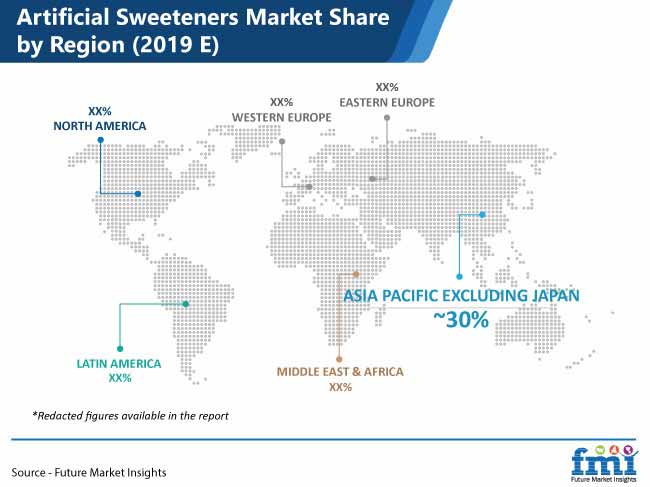Rise in awareness about risks of diabetes, increasing focus towards dental care, and increasing inclination towards weight management continue to fuel market for artificial sweeteners. The global consumption of artificial sweeteners is slated for 5% CAGR during 2019 – 2026. A new Future Market Insights (FMI) report projects that the demand for artificial sweeteners will be on a steady rise within food & beverages and pharmaceuticals industries.
- Artificial sweeteners have nearly zero calories in a serving as compared to a teaspoon of sugar, which contains approximately 16 calories. Increasing adoption of healthy lifestyles is, in turn, reducing sugar consumption across the globe. For instance, according to the U.S Department of Agriculture, sugar consumption in New York slumped by 25% in 2018 as compared to the previous year.
- Artificial sweeteners are increasingly used in manufacturing processed food products such as candies, jellies, baked goods, sauces, canned foods, ice cream, soft drinks, and yogurt, apart from various dairy products. Increasing preference for sugar-free products is a key artificial sweeteners market trend, which will bode well in the foreseeable future.
- Artificial sweeteners are used as preservatives in multiple canned and frozen food products. According to FAO, global frozen food products sales was valued at US$ 26 Bn in 2001. Consumption of frozen food products is increasing worldwide, creating a favorable environment for market growth.
- Healthy beverages consumption has seen a rapid rise in the recent past, on the back of increasing adoption of healthy lifestyles.
- Bakery goods and beverages will remain at the forefront in terms of demand, accounting for a collective value share of around 40%.
Request a report sample to gain comprehensive market insights @
https://www.futuremarketinsights.com/reports/sample/rep-gb-95
Research and development aimed at reducing hyper-intense sweetness of most artificial sweeteners and positioning these as diabetic-safe taste enhancers can pay rich dividends to manufacturers.

High Prevalence of Obesity Creating Favorable Market Conditions
The market is highly competitive, demonstrating the presence of small, medium, and large-scale players. According to the report, key players are competing in terms of brand recognition, taste, source of ingredients (natural or synthetic), quality, price, and service. To sustain their positions in the artificial sweeteners market, players are manufacturing high-quality artificial sweeteners with added benefits. Artificial sweeteners are low in fructose and have low calories. Artificial sweetener manufacturers are focusing on increasing production of natural artificial sweeteners, as health conscious consumers prefer natural sugar-free products. Obesity can lead to various diseases such as heart-related diseases, strokes and other cardiovascular diseases. According to a research conducted by the American Heart Association, in 2018, cardiovascular disease was listed as the underlying cause of death, accounting for nearly 836,546 deaths in the U.S.
For Information On The Research Approach Used In The Report, Ask Analyst @ https://www.futuremarketinsights.com/ask-question/rep-gb-95
Know More About Artificial Sweeteners Market Study
Future Market Insights, in its new report, offers an unbiased analysis of the global artificial sweeteners market, presenting historical demand data (2012-2018), and forecast statistics for the period, 2019-2026. The study divulges compelling insights into the artificial sweeteners market on the basis of product type (aspartame, acesulfame k, saccharin, sucralose, and neotame), end user (food & beverages, pharmaceuticals, direct sales, and other applications), application (bakery goods, sweet spreads, confectionery and chewing gums, beverages, dairy products, and others) across six major regions.
About Food Market Division at FMI
Expert analysis, actionable insights, and strategic recommendations – the food & beverage team at Future Market Insights helps clients from across the globe with their unique business intelligence needs. With a repertoire of over 1,000 reports and 1 million+ data points, the team has analysed the food & beverage industry lucidly in 50+ countries for over a decade. The team provides end-to-end research and consulting services; reach out to explore how we can help.